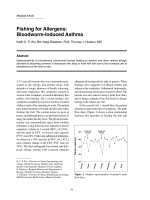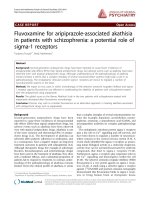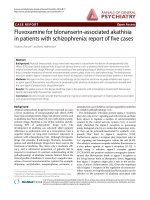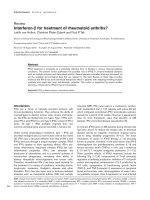Báo cáo y học: " Biomarkers for systemic lupus erythematosus: has the right time finally arrived" pdf
Bạn đang xem bản rút gọn của tài liệu. Xem và tải ngay bản đầy đủ của tài liệu tại đây (29.68 KB, 2 trang )
223
SLE = systemic lupus erythematosus.
Available online />The concept of ‘biomarkers’ is a concept that is, at once,
old and boring yet new and exciting. The notion that
pathogenesis, risk, and prognosis can be apprehended by
examining discrete aspects of the underlying disease
process is not new. The identification of such markers is
predicated on (1) understanding the disease process; (2)
identifying aspects of pathogenesis that can be reliably
and relatively easily determined; and (3) ascertaining that
there is a close relationship between the marker and the
outcome or characteristic of interest. In systemic lupus
erythematosus (SLE), we have been using clinical
indicators such as anti-double-stranded DNA antibodies
and complement levels to monitor disease activity for just
as long as we have been arguing about their sensitivity
and specificity. The arguments arise from the
heterogeneity of SLE patients with regard to clinical
presentation, course, and response to therapy. Genetic
factors and environmental contributors to risk and disease
manifestations make the picture even more complex.
Translate that to the modern era and you have ‘Biomarkers
in systemic lupus erythematosus I’ [1].
Gabor Illei and colleagues have done a remarkable review
of the literature in SLE in an attempt to identify markers, to
assess their likely utility in SLE, and to propose a schema
through which to test and apply them. The review of the
literature was done by traditional methods: searching by
key words and search engines, scouring the reference lists
and doing deeper-level searches, and reading the more
mechanistically inclined papers on SLE and immunology
and imputing the utility of aspects of pathogenesis to the
clinic. This comprehensive overview identifies possible,
promising, and unlikely biomarkers in SLE, suggests
schemata for validation, and makes the critical distinctions
between biomarkers and clinical or surrogate endpoints.
The latter distinction is of critical importance, and has
important implications for the applications for which
markers of various sorts might be useful.
A biomarker, according to Illei and colleagues, is ‘a
characteristic that is objectively measured and evaluated
as an indicator of normal biologic processes, pathogenic
processes, or pharmacologic responses to a therapeutic
intervention’. Clinical endpoints, however, are
‘characteristics or variables that reflect how a patient
feels, functions or survives’; and surrogate endpoints are
‘biomarkers that are intended to substitute for a clinical
endpoint. A surrogate endpoint is expected to predict
clinical benefit (or harm or lack of benefit or harm) based
on epidemiologic, therapeutic, pathophysiologic, or other
scientific evidence.’
Clinical and surrogate endpoints are primarily applicable to
outcomes in clinical studies and can contribute to the basis
for clinical decision-making, whereas biomarkers have a
much farther reach. Biomarkers, in general, can be used for
risk determination; for diagnosis; for subsetting patients
according to prognosis; for predicting and assessing
disease activity and status, as well as response to therapy;
and in assessing outcomes. Biomarkers are also, by virtue
of their short-term availability as predictors of longer-term
events, useful for ‘proof-of-concept studies’ in the develop-
ment or use of new or novel therapeutic interventions.
So, although Illei and colleagues have elegantly surveyed
the field and imposed order and expectations where these
were not previously articulated, why does this merit a
Viewpoint in Arthritis Research & Therapy? Several
reasons come to mind.
First is that the approach of the comprehensive overview
of an entire literature with respect to a single question is
Viewpoint
Biomarkers for systemic lupus erythematosus: has the right time
finally arrived?
Barbara B Mittleman
Science and Technology Branch/Chief, Scientific Interchange Section/National Institutes of Arthritis and Musculoskeletal and Skin
Diseases/National Institutes of Health/US Department of Health and Human Services, Bethesda MD, USA
Corresponding author: Barbara B Mittleman,
Published: 12 Aug 2004
Arthritis Res Ther 2004, 6:223-224 (DOI 10.1186/ar1186)
© 2004 BioMed Central Ltd
224
Arthritis Research & Therapy Vol 6 No 5 Mittleman
now in transition. New tools in informatics are making it
possible to fuel the search for biomarkers for SLE (for
example) rapidly and with nuance. Rather than looking for
articles using the same key words, or for bibliographic
citations in a work of interest, the entire database of
medical literature can be probed for the co-occurrence of
terms of interest in an iterative and indirect fashion. By
such strategies, it is now possible to make links that might
not be intutitively obvious, links for which data is published
but the implication has never been articulated, and novel
links connecting fields that historically have not
communicated [2]. Potentially informative biomarkers in
SLE have been identified by using the traditional methods
by Illei and colleagues, but current efforts are seeking to
reproduce and refine this with the more powerful
techniques of informatics and indirect inference (D Blair
and PE Lipsky, personal communication). This approach
has been used previously to good effect in several clinical
areas: identifying a relationship between magnesium and
migraine headaches that was previously unknown, and in
examining the role of fish oils in Raynaud’s phenomenon
[3,4]. These inferred associations were then tested
empirically with good success.
The second reason to focus on biomarkers in SLE at this
time is practical. The lack of validated biomarkers for SLE
disease activity and response to treatment have been
identified as barriers to drug discovery, development and
testing by clinical and basic researchers, industry, the US
Food and Drug Administration, and patient advocates.
Three meetings have been convened in 2003–2004 to
develop a strategy for identifying and validating such
markers, and the effort represents an unprecedented
collaboration between academics, industry, patient
advocates, and regulatory agencies. The steering and
scientific advisory committees of the SLE Biomarker
Working Group will be structuring the collaborative group,
seeking and administering funding, and initiating the
validation of the first five identified likely biomarkers for SLE.
Although the study of Illei and colleagues is the first
systematic global overview of the literature seeking likely
candidate biomarkers for validation in the near future, this
will not be the last word on the topic.
Competing interests
None declared.
References
1. Illei GG, Tackey E, Lapteva L, Lipsky PE: Biomarkers in systemic
lupus erythematosus. I. General overview of biomarkers and
their applicability. Arthritis Rheum 2004, 50:1709-1720.
2. Swanson DR: Medical literature as a potential source of new
knowledge. Bull Med Libr Assoc 1990, 78:29-37.
3. Swanson DR: Migraine and magnesium: eleven neglected
connections. Perspect Biol Med 1988, 31:526-557.
4. Swanson DR: Fish oil, Raynaud’s syndrome, and undiscovered
public knowledge. Perspect Biol Med 1986, 30:7-18.









